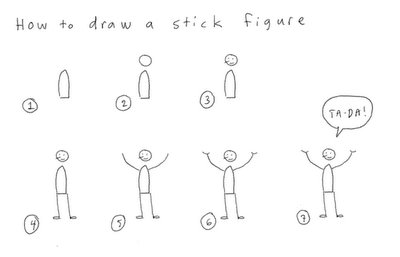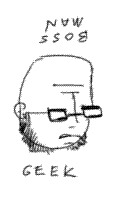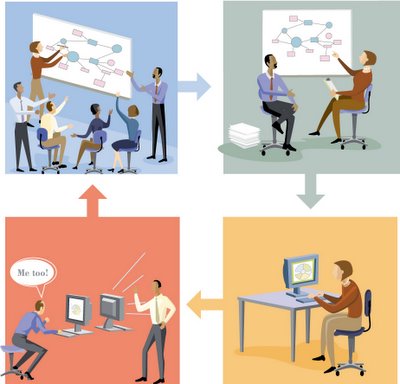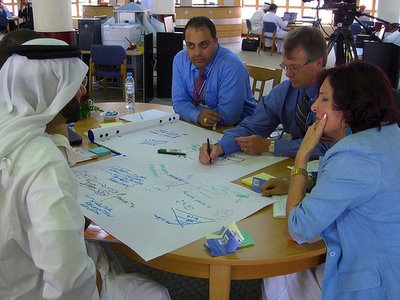 Cliff Atkinson asked
Cliff Atkinson asked if I would show how to draw a stick figure, so I decided to let you in on a little trade secret: All stick figures are
not created equal. Today I'm going to teach you to draw a stick figure the way we do it at XPLANE.
Stick figures are a quick and easy way to visually represent the human body doing just about anything. I'm going to start you off easy by showing you how to draw a simple standing figure.
Here's a larger image of the drawing above.
1. Most people start a stick figure by drawing the head. This is a mistake. Since a stick figure represents the whole person, the best way to draw it is the way you see a whole person. Think about what you notice first when seeing someone from a distance. Always start with the body. The body is the center of gravity and motion. By starting with the body you will capture the essence of the gesture you want to convey.
2. After you have drawn the body in the position that you want, draw in a circle for the head. The placement of the head in relation to the body is essential. Happiness, angst, speed and sluggishness can all be conveyed by the relative positions of the head and body. Observe people doing their daily routines and you'll see what I mean.
3. Next, draw the facial expression. Your basic smiley face or frowney face will work here just fine. Adding a little line for a nose will help you show which direction the head is pointing. This can be especially important when you want to show two people interacting with each other.
4. Add the legs next -- they are more essential to conveying the gesture than the arms. When my basketball coach taught me to shoot, he explained that the primary energy that propels the ball comes not from your arms but from your legs (Watch some basketball on TV and you can actually see this). The energy of a stick figure works the same way. Note the use of small ovals to represent feet. This helps connect the person to the imaginary ground.
5. Now draw the arms, and complete the gesture you started with the legs.
6. I made the hands a separate step so you could see what a difference a couple of little lines makes. A short, one-line stroke will suffice for nearly any gesture.
7. Of course you're drawing the stick figure to convey some idea, action or emotion. Thought bubbles and word balloons are a great way to round out the complete thought.
Now that you've drawn a standing person, try your hand at some more tricky problems:
- How would you draw a tall person? A fat person? Someone with long hair or a beard?
- Go to a public place and see if you can capture the gestures of the people around you in stick-figure drawings. This is a great way to hone your observation skills.
- See if you can draw people running, dancing, fighting and sitting.
- Here's a hard one: draw a stick figure riding a bike.
Please send me your drawings so I can share your successes!
Read more about sketching in visual thinking school.
Keep in touch! Sign up to get updates and occasional emails from me.
























 Cliff Atkinson asked
Cliff Atkinson asked









 "For too long typographic style and its accompanying attention to detail have been overlooked by website designers, particularly in body copy. In years gone by this could have been put down to the technology, but now the web has caught up. The advent of much improved browsers, text rendering and high resolution screens, combine to negate technology as an excuse.
"For too long typographic style and its accompanying attention to detail have been overlooked by website designers, particularly in body copy. In years gone by this could have been put down to the technology, but now the web has caught up. The advent of much improved browsers, text rendering and high resolution screens, combine to negate technology as an excuse.










